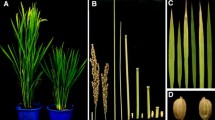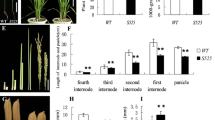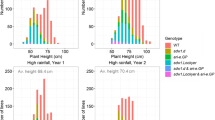Abstract
Key message
We obtained interesting results for genetic analysis and molecular mapping of the du12(t) gene.
Abstract
Control of the amylose content in rice is the major strategy for breeding rice with improved quality. In this study, we conducted genetic analysis and molecular mapping to identify the dull gene in the dull rice, Milyang262. A single recessive gene, tentatively designated as du12(t), was identified as the dull gene that leads to the low amylose character of Milyang262. To investigate the inheritance of du12(t), genetic analysis on an F2 population derived from a cross between the gene carrier, Milyang262, and a moderate amylose content variety, Junam, was conducted. A segregation ratio of 3:1 (χ 2 = 1.71, p = 0.19) was observed, suggesting that du12(t) is a single recessive factor that controls the dull character in Milyang262. Allelism tests confirmed that du12(t) is not allelic to other low amylose controlling genes, wx or du1. Recessive class analysis was performed to localize the du12(t) locus. Mapping of du12(t) was conducted on F2 and F3 populations of Baegokchal/Milyang262 cross. Linkage analysis of 120 F2 plants revealed that RM6926 and RM3509 flank du12(t) at a 2.38-Mb region. To refine the du12(t) locus position, 986 F2 and 289 F3 additional normal plants were screened by the flanking markers. Twenty-six recombinant plants were identified and later genotyped with four additional adjacent markers located between RM6926 and RM3509. Finally, du12(t) was mapped to an 840-kb region on the distal region of the long arm of chromosome 6, delimited by SSR markers RM20662 and RM412, and co-segregated by RM3765 and RM176.




Similar content being viewed by others
Abbreviations
- du :
-
Dull
- RM:
-
Rice microsatellite
References
Allahgholipour M, Ali AJ, Alinia F, Nagamine T, Kojima Y (2006) Relationship between grain rice amylose and pasting properties for breeding better quality rice varieties. Plant Breed 125(4):357–362
Ando I, Sato H, Aoki N, Suzuki Y, Hirabayashi H, Kuroki M, Shimizu H, Ando T, Takeuchi Y (2010) Genetic analysis of the low-amylose characteristics of rice cultivars Oborozuki and Hokkai-PL9. Breed Sci 60:187–194
Dung LV, Mikami I, Amano E, Sano Y (2000) Study on the response of dull endosperm 2-2, du2-2, to two alleles in rice. Breed Sci 50:215–219
Isshiki M, Nakajima M, Satoh H, Shimamoto K (2000) Dull: rice mutants with tissue-specific effects of the waxy pre mRNA. Plant J 23(4):451–460
Isshiki M, Takasaki A, Wong HL, Satoh H, Shimamoto K (2008) Du3, a mRNA cap-binding protein gene, regulates amylose content in Japonica rice seeds. Plant Biotechnol 25:483–487
Juliano BO (1971) A simplified assay for milled-rice amylose. Cereal Sci Today 16:334–340
Kaushik RP, Khush GS (1991) Genetic analysis of endosperm mutants in rice Oryza sativa L. Theor Appl Genet 83:146–152
Kinoshita T, Kikuchi H (1987) Inheritance of amylose content in crosses of low amylose mutants. Rice Genet Newsl 4:83–84
Kiuchi H, Numao Y, Hirayama Y, Maekawa T, Kinoshita M, Aikawa M, Kikuchi H, Tanaka K, Tanno H, Satoh T, Shinbashi N, Taberi K, Sasaki K, Yoshida M, Maeda H, Sugawara K (2009) A rice variety “Ayahime”. Bull Hokkaido Prefect Agric Exp Stn 93:13–24
Koh HJ, Heu MH (1997) Some mutants for grain quality in rice. In: Harmonizing agricultural productivity and conservation of biodiversity breeding and ecology Proceed 8th SABRAO Congress and Annual Meeting of Korean Breed Soc pp. 119–120
Kumar I, Khush GS (1986) Gene dosage effect of amylose content in rice endosperm. Jpn J Genet 61:559–568
Kumar I, Khush GS (1988) Inheritance of amylose content in rice (Oryza sativa L.). Euphytica 38:261–269
Kunihiro Y, Ebe Y, Shinbashi N, Kikuchi H, Tanno H, Sugawara K (1993) A new paddy rice variety “aya” with good eating quality due to low amylose content developed by anther culture breeding. Jpn J Breed 43:155–163
Larkin PD, Park WD (2003) Association of waxy gene single nucleotide polymorphisms with starch characteristics in rice (Oryza sativa L.). Mol Breed 12:335–339
Ni D, Zhang S, Chen S, Xu Y, Li L, Li H, Wang Z, Cai X, Li Z, Yang J (2011) Improving cooking and eating quality of Xieyou57, an elite indica hybrid rice, by marker-assisted selection of the Wx locus. Euphytica 179:355–362
Okuno K, Nagamine T, Oka M, Kawase M, Katsuta M, Egawa Y, Nakagahra M (1993) New lines harboring du genes for low amylose content in endosperm starch of rice. JARQ-Jpn Agr Res Q 27:102–105
Sano Y, Katsumata M, Okuno K (1986) Genetic studies of speciation in cultivated rice. 5. Inter- and intraspecific differentiation in the Waxy gene expression of rice. Euphytica 35:1–9
Sato H, Suzuki Y, Sakai M, Imbe T (2002) Molecular characterization of Wx-mq, a novel mutant gene for low-amylose content in endosperm of rice (Oryza sativa L.). Breed Sci 52:131–135
Satoh H, Omura T (1981) New endosperm mutations induced by chemical mutagens in rice Oryza sativa L. Jpn J Breed 31(3):316–326
Satoh H, Matsusaka H, Kumamaru T (2010) Use of N-Methyl-N-nitrosourea treatment of fertilized egg cells for saturation mutagenesis. Breed Sci 60:475–485
Shuichi I, Yoishihiro S (2004) A new rice cultivar with good eating quality (Low Amylose) and low glutelin protein, “LGCsoft”. Bull Natl Agr Res Center Western Region 3:57–74
Tan YF, Li JX, Yu SB, Xing YZ, Xu CG, Zhang Q (1999) The three important traits for cooking and eating quality of rice grains are controlled by a single locus in an elite rice hybrid, Shanyou 63. Theor Appl Genet 99:642–648
Wang ZY, Zheng FQ, Shen GZ, Gao JP, Peter Snustad D, Li MG, Zhang JL, Hong MM (1995) The amylose content in rice endosperm is related to the post-transcriptional regulation of the waxy gene. Plant J 7(4):613–622
Wang C, Zhang Y, Zhu Z, Chen T, Zhao L, Lin J, Zhou L (2009) Development of a new japonica rice variety Nan-jing 46 with good eating quality by marker assisted selection. Mol Plant Breed 7(6):1070–1076
Yano M, Okuno K, Satoh H, Omura T (1988) Chromosomal location of genes conditioning low amylose content of endosperm starches in rice, Oryza sativa L. Theor Appl Genet 76:183–189
Zeng D, Meixian Y, Wang Y, Liu X, Qian Q, Jiayang L (1997) Du1, encoding a novel Prp1 protein, regulates starch biosynthesis through affecting the splicing of Wxb pre-mRNAs in rice (Oryza sativa L.). Plant Mol Biol 65:501–509
Zhang Q, Shen BZ, Dai XK, Mei MH, Saghai Maroof MA, Li ZB (1994) Using bulked extremes and recessive class to map genes for photoperiod-sensitive genic male sterility in rice. Proc Natl Acad Sci USA 91(18):8675–8679
Acknowledgments
This work was supported by a grant from the Next-Generation Biogreen 21 Program (PJ0080912013) of the Rural Development Administration, Republic of Korea. We sincerely thank Kyungpook National University for their donation (International Scholarship Scheme) to G. Kiswara.
Conflict of interest
None.
Author information
Authors and Affiliations
Corresponding author
Additional information
Communicated by Y. Xu.
Electronic supplementary material
Below is the link to the electronic supplementary material.
Rights and permissions
About this article
Cite this article
Kiswara, G., Lee, JH., Hur, YJ. et al. Genetic analysis and molecular mapping of low amylose gene du12(t) in rice (Oryza sativa L.). Theor Appl Genet 127, 51–57 (2014). https://doi.org/10.1007/s00122-013-2200-z
Received:
Accepted:
Published:
Issue Date:
DOI: https://doi.org/10.1007/s00122-013-2200-z




